5 Great Ways to Choose the Ideal Horse Riding Boots
When it comes to horseback riding, having the right gear is essential—not just for style, but for safety, comfort, and performance. One of the most important investments a rider can make is a good pair of horse riding boots.
The right boots provide stability, grip, and protection while ensuring a comfortable ride. But with so many styles and materials to choose from, how do you find the perfect pair?
In this guide, we will look at the different types of horse riding boots. We will also discuss what to think about when buying them. Finally, we will cover how to care for your boots to make them last.
Why Proper Horse Riding Boots Matter
Wearing the right horse riding boots isn’t just about looking the part—it’s about safety and performance. These boots are specifically designed to provide:
- A secure grip in the stirrups – The right heel height and sole design help prevent your foot from slipping. Too much traction, however, can trap your foot in the stirrup when you need or want it to release. Riding boots have a sole design that offers just enough traction for grip without it being too much.
- Ankle and leg support – High-quality boots support your ankle in the stirrup. Taller boots will prevent pinching or chafing from the saddle and stirrup leathers while also supporting your ankles.
- Durability and protection – Horseback riding involves exposure to dirt, mud, and difficult terrain. A good pair of boots withstands the elements while keeping your feet protected.
Types of Horse Riding Boots
There are several types of horse riding boots, each designed for specific disciplines and preferences. Understanding the differences will help you make the best choice for your needs.
Tall Boots
Tall boots are often used for formal riding disciplines like dressage, show jumping, and eventing. They provide additional support and a polished look. The two main types include:
- Field Boots – Feature a laced area near the ankle for more flexibility. Ideal for jumping and general riding.
- Dress Boots – A sleek, non-laced design commonly used in dressage and formal competitions.

Paddock Boots
Paddock boots, also known as jodhpur boots, are shorter and stop just above the ankle. They are great for everyday riding, barn work, and beginner riders. Many riders pair them with half chaps to provide additional leg protection.

Western Riding Boots
For those who prefer Western riding, cowboy-style boots are the go-to option. They have a sturdy leather design, a slight heel, and a comfortable fit for long hours in the saddle.

Endurance and Trail Riding Boots
Designed for long-distance rides, endurance boots offer comfort, breathability, and flexibility. They often have reinforced soles for better traction on rough terrain.

Factors to Consider When Choosing Horse Riding Boots
Now that you know the different types, here’s what to consider when selecting the perfect pair of horse riding boots:
Fit and Comfort
Comfort is key when choosing riding boots. Ill-fitting boots can cause blisters, discomfort, and even impact your riding performance. When trying on boots, ensure:
- There’s enough room to wiggle your toes.
- The heel doesn’t slip excessively when walking.
- The boot provides good arch support and flexibility.
Material: Leather vs. Synthetic
- Leather Boots – Durable, stylish, and breathable. They mold to your feet over time but require regular care.
- Synthetic Boots – More affordable and easier to maintain but may not be as long-lasting as leather options.
Heel Height and Sole Grip
A proper horse riding boot should have a slight heel (usually around 1-1.5 inches) to prevent your foot from slipping through the stirrup. Rubber or textured soles provide a better grip for stability.
Closure Style
- Zipper boots – Convenient and easy to wear.
- Lace-up boots – Offer a snug, adjustable fit.
- Pull-on boots – Traditional design but may take more effort to put on and remove.
Budget and Brand
There are boots available at all price points, from budget-friendly consignment and synthetic options to high-end, custom leather boots. Well-known brands often provide better craftsmanship and durability.
Caring for Your Horse Riding Boots
To extend the life of your boots and keep them in top condition:
- Clean them after each ride – Use a damp cloth to remove dirt and dust.
- Condition leather boots – Apply leather conditioner to prevent cracking.
- Store them properly – Keep boots in a dry, cool place and use boot trees to maintain their shape.
- Check zippers and laces regularly – Replace worn-out laces or broken zippers to avoid unexpected issues.
Choosing the right horse riding boots is essential for comfort, performance, and safety. You need tall boots for competitions, paddock boots for daily riding, or Western boots for trail adventures. Finding the right fit and style is important. Invest in a quality pair, take care of them properly, and enjoy your time in the saddle with confidence.

